HEARTSIGHT
CHRISTINA LLANES MABALOT
Transformer Homes: Fun and Function
In the new norm, an accessible home also breaks distance, cultural, attitudinal, informational, and spiritual barriers. The truly fantastic thing about working or schooling from home is that obstacles that required special considerations in the classroom or office can be eliminated altogether.
The first place I called home was my parents', where I grew up and got established. At that time, accessibility was unheard of. Out of sheer common sense, my parents brightened up our house and study tables with fluorescent lights to aid their four visually-impaired children's vision. Nothing fancy, but our home was a place of nurture, security, and love. I cherish the memories of my home when I was a little girl. I remember sitting on my father's lap as he read me stories, savoring my mother's yummy meals, playing with my siblings and puppies, and riding my three-wheel bike in the yard.
As a schoolgirl, I anticipated coming home to my family, who understood how visually-impaired children did things differently. Home was where I could spend hours on the phone talking to friends, including boyfriends when I was a teenager. In college, our home was a weekend destination after a week of rigorous academic work and living in the dorm in starvation. Later, as a young entrepreneur, the house would become my little schoolhouse, where I developed my skills as a young educational leader.
As I advanced in years, homes also shifted with changing roles, status, and locations. I can never forget moving into my husband's house in a city on top of a mountain, about 200 miles away from an older home. Their original family house crumbled after a catastrophic earthquake, so he built a makeshift house from materials he salvaged from the ruins of the building. Initially, I was thrilled with the fantasy of playing house, but that soon became a nightmare. The walls were sharp-edged metal sheets, and the creek beside the house had no safety ledges. All I could think of was self-preservation. This precarious situation pushed my husband to build my dream house, one that accommodated our unique needs, as well as our vision for the family. That apartment building became the base for all our business ventures and was to be our retirement home.
Today, the pandemic expands our imagination of the uses of rooms and houses for multiple purposes. Homes are no longer just a place people retreat to after work, school, church, or a long, tiring day. Home is where you grind, learn, exercise daily, and worship weekly. The same home must also be a haven where individuals and families get to bond with its members, rest and play.
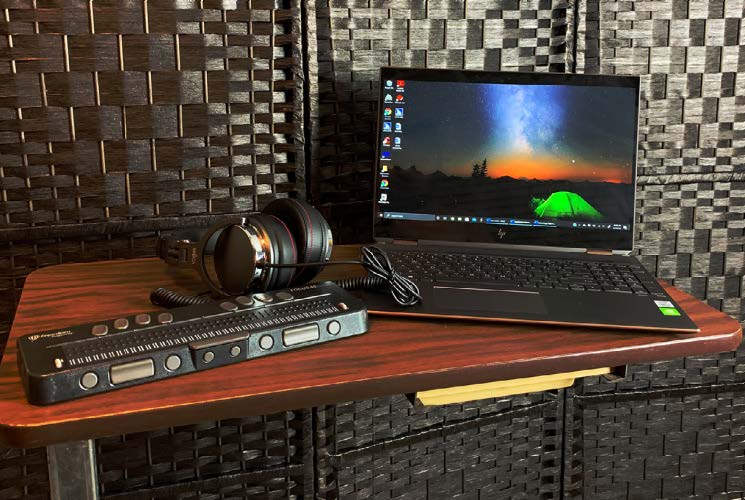
WORKING SMART: The author's desk with laptop, Braille display, and noise cancelling headphones - a simple set up for people who are blind and working from home
Homes today have become like Transformer robots that conveniently turn into different forms.
HOME IS THE NEW WORKPLACE
September 2018 marked a breakthrough in my perception of the possibilities of home and career. Home businesses had always worked for me, but working from home in corporate America seemed foreign. Regardless, I transitioned into working from home, from a brick and mortar business setting to my residence. It was a win-win situation for a visually-impaired employee. I would gain my independence, not relying on someone to drive me to the office. I could use an extra four hours more for self-improvement because I wouldn't have to dress up, pack lunch and snacks, and travel. Operating in the comfort of my own home would be less stressful; I could eat anything I wanted in my kitchen, and use my private restroom. I could even wear my comfy panda pajamas.
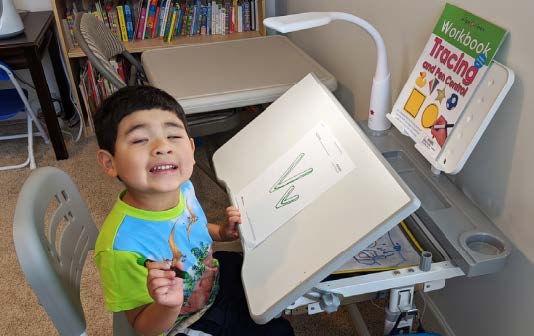
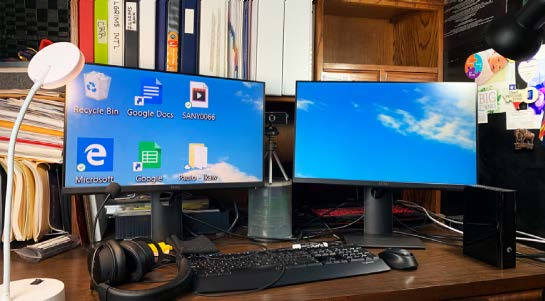
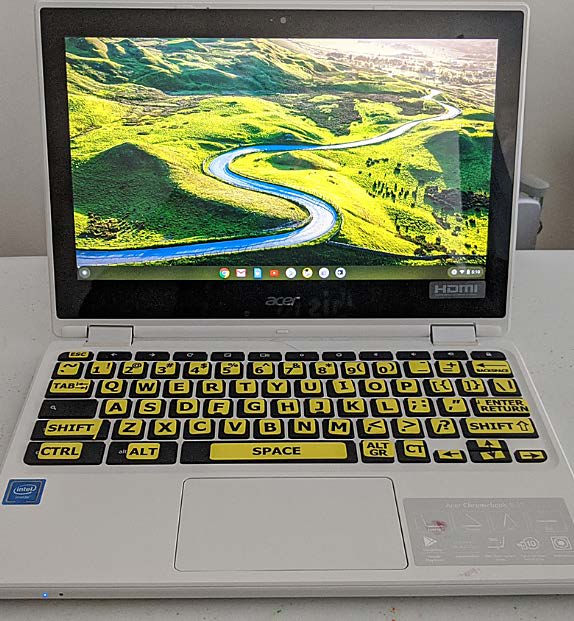
TECH CHECK: (Clockwise from top left) Chippy, a toddler with low vision, studying on an adjustable desk with integrated lamp; Chippy's computer, a Chromebook with large print for people with low vision, has a keyboard labeled high contrast stickers to make typing easier; and the items on Jem's desk show that people with low vision use more hardware and assistive peripherals.
It took months for our company to equip their visually impaired employees to function at an optimum when working from home and making support and assistance accessible when needed. On my end, I had to set up an accessible office area and fix up our house so that I could conveniently run from my office to the restroom, kitchen, or anywhere I needed to go. Fortunately, we had a flex room over the garage. It was my exercise room, a graveyard for old furniture, and storage for things we hoarded.
DECLUTTERING
Truth is, we would have been wealthier if we hadn't purchased all the things we hoarded. The first step to repurposing a room is decluttering. These days, my set up is simple. It consists of my laptop and Braille display on a sit-stand desk. There's ample space for my water bottle and, more important, my snacks. Relying entirely on my hearing for information, I use noise-cancelling headphones. Under the desk is a basket of hygiene supplies and miscellaneous items. On the other side is a trash bin with a motion sensor. My ergonomic chair makes me feel like I'm the chief executive officer. But sitting through an eight-hour shift triggers sciatic nerve pain, so I stand on a gel pad periodically and adjust my desk height to comfort level.
During short breaks and one-hour lunchtimes, I rejuvenate my mind by rejoining my family, playing with my dog, or doing chores. As my activities are timed, easy and quick access to and from the office is essential. My husband, whose passion is decorating, once lined the walls of our house with ornamental plants, jars, and a credenza. I had hoped that I could safely and quickly trail around the house clutter-free, but the decorations made it quite difficult. When the battle is between aesthetics and accessibility, the deciding factors are purpose and priority; in other words, my employment and safety. So, my husband eventually made a sacrifice by removing his precious decorations along the wall—so I can securely glide across the house.
MY DAUGHTER'S WORK SPACE
A year later, my daughter got her foot in the door to the promising world of online English teaching. It was a perfect fit for Jem, an ambitious, visually-impaired, and fresh graduate, determined to further her education while working part-time. There was room for her in my office, size-wise, but setting up her work area entailed more labor. We went through a second round of decluttering, only this time, more painful since we needed to clear out a bigger space.
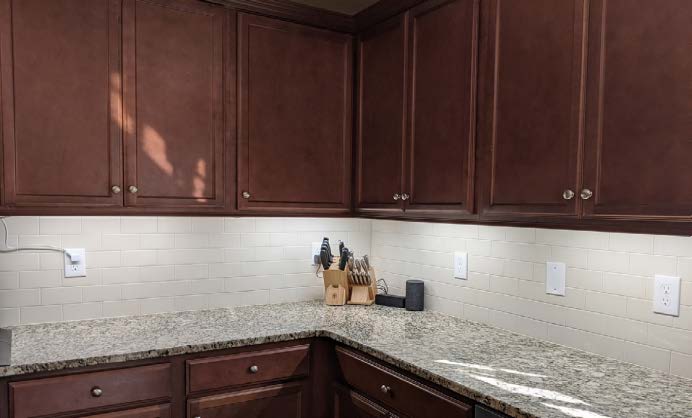



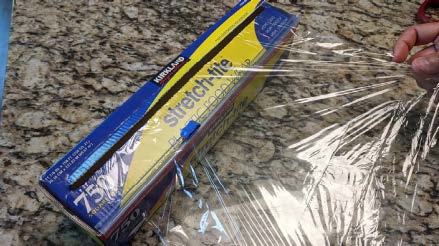
KITCHEN CONFIDENCE: (Clockwise from top left) In a well designed kitchen, under-the-counter lights aid people with low vision when preparing food; Induction stove technology puts an end to the safety hazard for people who are blind or visually-impaired when cooking. One can touch and even clean the stove while it's on and not get burned; "Clean" and "dirty" large print or Braille dishwasher signs for people with low vision or hearing impairment; and this special packaging with a sliding cutter makes cutting plastic wrap easy and neat.
People with low vision usually utilize more assistive hardware and peripherals for better perception, so she occupied the inner and more significant part of the room. A tall shelf borders our workstations, and we also installed a desk huge enough to accommodate two large monitors, a laptop, keyboard, mouse, and lamps. Since our accessibility configurations are so different, we laid out house rules to maintain a healthy work environment. Conditions included the following: things we needed, like remote controls for the AC and fans, were supposed to be returned to the designated area. She shouldn't move anything in my workstation, and I am technically restricted from her workstation since I might trip on wires or mess up her gadgets. Respect for our individual preferences and differing requirements resulted in productivity and harmony.
THE PANDEMIC THROWS A CURVEBALL
Thus far, we had a room dedicated as an office for my daughter and me, until the pandemic threw a curveball. During the lockdown, my husband, too, had to work from home, and my son's classes were to be conducted online. Since all rooms were occupied, we decided to enclose my hus band's side of our bedroom and convert it to his office. On this third round of decluttering, shelves, books, gadgets, electronic devices were sold. My husband has a mobility impairment. He needed a wider walkway to his cubicle, more leg space under the table, as well as an area where he can do stretching exercises when needed. Afflicted with carpal tunnel, he also needed the best ergonomic desk and keyboard to limit pain. He enjoyed his work station so much that it has become his man-cave.
The three office areas in our house are laid out differently and explicitly configured for the individual end-users. I'm blind, my daughter has low vision, and my husband is mobility impaired. Home office accessibility is the set-up that optimizes productivity, effectivity, and comfort, designed according to personal preferences, space, and household activities. There is no one-size-fits-all accessibility design according to differing disabilities. Take, for example, a colleague who is also a blind, home-based employee. Although there's a spare room in his house he could use as his office, he chose to set up his workstation in his bedroom so he could roll out of bed and log in for work. If I were in his place, I'd probably stay in bed, clicking my snooze button all day, and work would turn out to be my worst nightmare.
THE BENEFITS OF WALLS OR GLASS DOORS
Installing glass doors or walls could be an option for homebased working mothers. They would benefit from a quiet environment while supervising a child with special needs participating in online classes. The structure could provide both the mother and child the reminder they need to perform their roles. This glass structure could also work well for people with hearing impairment who may feel isolated while working. An uninterrupted view of activities in the house through the glass wall could make one feel connected with the family. Cameras linked to apps on mobile devices or laptops might be a cheaper option if such devices could serve their purpose. For people with hearing impairment, I recommend early warning devices like security systems and smoke alarms to be always connected to their mobile devices.
HOME IS THE NEW SCHOOL
After my daughter's graduation, my husband and I thought we were going to be empty nesters, but the pandemic brought our fledglings back home. However, living at home is one thing, and studying from home is another. One would assume that the kids would attend their virtual classes in their bedrooms, but that isn't the case with mine. The kids feel that sitting at a desk next to the bed while listening to a lecture would put them to sleep. Longing to be in a physical classroom environment, my daughter, my son, and his girlfriend take their laptops to the dining table where they study. What a perfect e-school, learning at your fingertips amidst co-learners, snacks within reach, and just a few steps away to the bedrooms. For children with short attention spans, parents can schedule short breaks for them every few minutes depending on how long they can stay focused. Eliminating possible sources of distraction such as flashy lights, fancy decorations, or the TV could also be helpful. For accessibility purposes, often, less is more. If a child gets anxious or claustrophobic in a tight area, moving the desk next to a window might help. Parents may opt to set a screen or painting of nature, use aromatherapy, or play calming white noise in the background. The idea is to make their workspaces feel comfortable and enhance productivity.
HOME IS THE NEW CHURCH
As the lockdown included the closure of church buildings, worship services and activities were brought to the living rooms of homes through various digital platforms. Churches have grown in attendance more than ever before, and families have never been as united in participating in religious activities. People with hearing impairment mostly benefit from online church through the Live Caption app. According to Google, Live Caption is an impressive technology that you can use to create real-time captions for videos, podcasts, or even voice notes on your phone.
HOME IS THE NEW GYM
Isolation from the world outside is not an excuse for a sedentary lifestyle. Gyms are temporarily closed, but we can still find ways to stay active and healthy. I can't go to the gym regularly unless someone drives me, but I have exercise equipment at home that I can access anytime. If buying equipment is not in your budget, there are various ways you can improvise. For example, you can go up and down a single step in your house the way you would on an aerobic stepper. Large laundry detergents with handles can be used as weights, or you can search for videos of home workouts that can be done in a small area. You can be creative about exercising at home for as long as it's safe.
CONCLUSION
Accessibility goes beyond the physical layout of the house. In the new norm, an accessible home also breaks distance, cultural, attitudinal, informational, and spiritual barriers. I encourage individuals to follow routines, respect spaces and seek resources, technology, materials, and services to achieve goals efficiently and cost-effectively. This way, family members can handle the demands of work, school, church, and gym – now relocated to what had typically been a living and entertainment space.
The truly fantastic thing about working or schooling from home is that obstacles that required special considerations in the classroom or office can be eliminated altogether. Those who are blind don't need orientation and mobility sessions, one-onone instructions, or notetakers. For the hearing-impaired, interpreters could be replaced by close captioning or voice-to text technology. Moms can now actually sit in their children's classes and connect more with online communities for networking and additional resources.
Accessibility gives freedom, but it requires responsibility, a vision, and discipline. If we are accountable to ourselves before an educational institution or workplace, then liberty can thrive in our homes. Finally, accessibility in the home begins with the mindset that we are able, not disabled, so home is what we make it to be.•
THE GREAT EQUALIZER : TECHNOLOGY EXPANDS ACCESSIBILTY FOR PEOPLE WITH DIFFERING ABILITIES
New technology innovations have features that people with special needs can utilize to increase efficiency of homemakers, students or workers with disabilities.
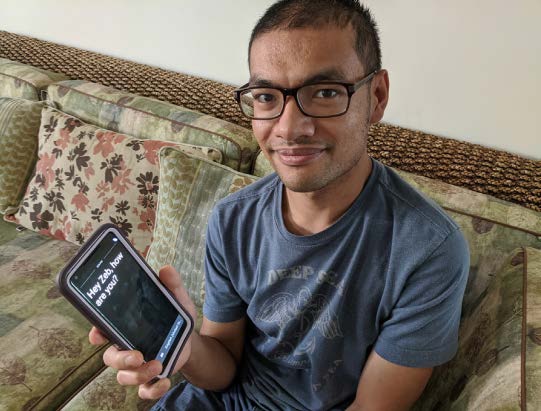
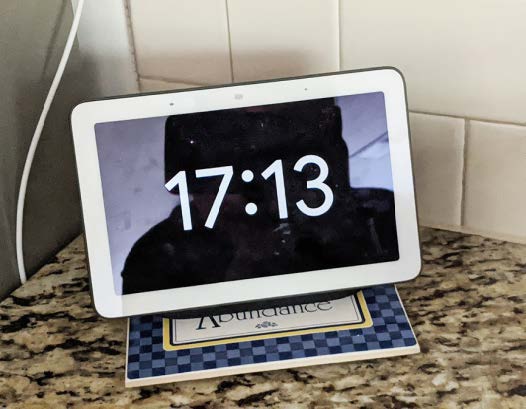
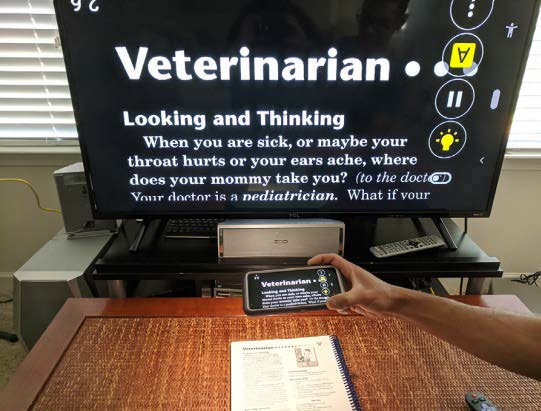

DEVICE SQUAD: Developers are helping those impacted by the pandemic as well as those with differing abilities get their school and office work done. (Clockwise from top left) Zeb holds a phone with Live Transcribe, an app for people with hearing impairments that transcribes speech to text in real time; a large screen TV and a phone with the Chromecast application help people with low vision read textbooks; a screen capture of a live video of a church service; and Google Home Hub showing the time, an important convenience for people with low vision.

HEARTSIGHT
Christina Llanes Mabalot is physically blind from aniridia, but has a vision. She enjoys touching people's lives to bring out the best in them. "Heartsight" explains her ability to see with her heart. Christina earned her B.A. degree and Masters in Education from the University of the Philippines, Diliman, specializing in Early Intervention for the Blind. She later received Educational Leadership training through the Hilton-Perkins International Program in Massachusetts, then worked as consultant for programs for the VI Helen Keller International. She has championed Inclusive Education, Early Intervention, Capability Building and Disability Sensitivity programs. She was twice a winner in the International Speech contests of the Toastmasters International (District 75) and has been a professional inspirational and motivational speaker. Christina is blissfully married to Silver Mabalot, also physically impaired, her partner in advancing noble causes. Their children are Paulo and Jem, who has aniridia.